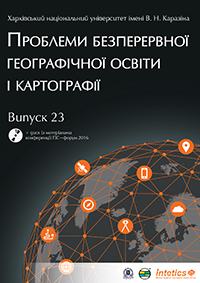Three-dimensional modeling of the territory and water area of national nature park «Nyzhnosulskyi» using GIS
Abstract
The article presents the experience in developing digital elevation models (DEMs) of Sulska Cove’s territory and water area near the national park «Nyzhnosulskyy». General digital models were created using existing topographic and bathymetric maps. The processing and data visualization were performed with GIS technologies applications. DEMs present as the basis for a comprehensive study of the national park’s landscape diversity as well as means of fundamental ways of its functioning and activity optimization. The required usage of 3D-modeling representation of NNP «Nyzhnosulskyy» is explained by its better visualization and interpretation of the data. In general, it allows information exchange about the changes of the environmental objects under research. At the same time, it decreases a list of applied tasks which were not possible to be solved using two dimensional data. The tasks which can be solved with the help of digital elevation modeling are very different, especially the following:
- inclination and slope exposure calculation;
- analysis of the runoff area;
- the network of thalwegs and watersheds network generalization, generation of the form a carcass relief system,
special points and lines of the relief, local minima (depression) and local maxima;
- ortho-correction of the images;
- measuring the areas and volumes, received from the surface profiles;
- viewing the data in three dimensions, virtual flights creation and light-and-shadow models;
- precise definition of the space and geographical coordinates of the objects;
- combining thematic layers of the digital map, especially air- and space shots using 3D objects;
- performing the realistic representation of the territory and virtual mobility as to the model;
-the analysis of the visibility zones;
- conducting the extrapolation of the longitude points
DEMs of the surface and the based map are integrated into one map, using the com mon scale for depths and altitudes which gives a better image of the territory (and water area) of the NNP. The creation of this model permits to define the flooded area and to predict the changes in landscape structure of the territory. The relative DEM from Sula Cove’s water area bottom was created based on that data. Using the cartographical composition, the separation of the water landscapes of different types with the complex analysis of the bottom and special biota distribution will be provided.
Downloads
References
2. Василиха І. Особливості цифрового моделювання складних типів рельєфу / І. Ю. Василиха // Геодезія, картографія та аерофотознімання. – 2007. – Вип. 68. – С. 269-279.
3. Глотов А. Геоинформационное моделирование долинно-речных ландшафтов Среднерусской лесостепи/ А. А. Глотов, В. Б. Михно // Вестник ВГУ. – 2013. – Вип. 1. – C. 47-52.
4. Дорожинський О. Л. Фотограмметрія / О. Л. Дорожинський, Р. Тукай. – Львів: Видавництво Національного університету «Львівська політехніка», 2008. – 332 с.
5. Кузик З. Цифрове моделювання рельєфу засобами ГІС-технологій для Національного Карпатського заповідника «Сколівські Бескиди» / З. Кузик // Зб. наук. пр. Зах. геодез. т-ва УТГК. – 2010. – Вип. 1. – С. 242-246.
6. Луцанова А. М. Особливості створення та візуалізації 3D моделей рельєфу за допомогою сучасних програмних продуктів / А. М. Луцанова // Часопис картографії. – 2013. – Вип. 7. – С. 44-52.
7. Митчелл Э. Руководство ESRI по ГИС анализу. Географические закономерности и взаимодействия / Э. Митчелл. – М: МГУ, 2001. – 190 с.
8. Мусин О. Р. Цифровые модели для ГИС / О.Р. Мусин// Информационный бюллетень ГИС Ассоциации. – 1998. – Вип. 4(16)-5(17). – С.28–29.
9. Мкртчян О. С. Принципи автоматизованого ландшафтно-екологічного картування [Електронний ресурс] / О. С. Мкртчян. – Режим доступу : http://www.lnu.edu.ua/faculty/geography/Strukt/Biblio/alphavit/Ukr/Ukr%20M/Mkrtchian/12.pdf
10. Пузаченко Ю. Г. Многовариантность картографического отображения ландшафта / Ю. Г. Пузаченко, Д. Н. Козлов // Материалы XI международной ландшафтной конференции «Ландшафтоведение: теория, методы, региональные исследования, практика». – 2006. – С. 123-125.
11. Сінна О. І. Тривимірне моделювання за допомогою ГІС та його використання у ландшафтно-екологічних дослідженнях [Електронний ресурс] / О. І. Сінна. – Режим доступу: http://dspace.univer.kharkov.ua/handle/123456789/4102.
12. Суховірський Б. І. Географічні інформаційні системи / Б. І. Суховірський. – Чернігів: Державний інститут економіки і управління, 2000. – 196 с.
13. Филатов В. Н. Основные проблемы пространственного представления местности в цифровых картографических изделиях / В. Н. Филатов, К. В. Мазур // Геодезия и картография. – 2007. – Вип. 4. – С. 35-38.
14. Фирсов Г. Ю. Цифровые модели рельефа дна в электронной геодезии / Г. Ю. Фирсов // Геодезия и картография. – 2008. – Вип. 4. – С. 49-53.
15. Хромых В. В. Цифровые модели рельефа: Учебное пособие / В. В. Хромых, О. В. Хромых. – Томск : ТМЛ-Пресс, 2007. – 164 c.





